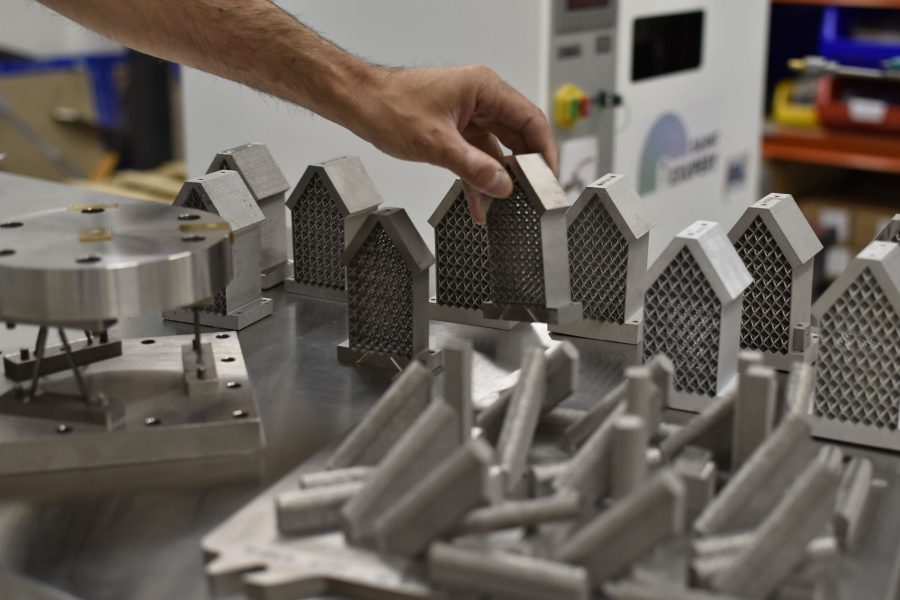Since 2016, the IRT Saint Exupéry has been working in close collaboration with 15 industrial members and 4 academic members on establishing links between mechanical performance, microstructures, and parameters of metal additive manufacturing processes, with a view to their wider industrial use in the aeronautics and space sectors. The research work carried out within the framework of the ANDDURO project (ANalysis of Defects and DURability Optimisation) was financed, in part, by the PIA (Programme d’Investissements d’Avenir), the Occitanie Region, and the industrial members of the project.
At the end of this five-years-long project, the team is making available a part of the results generated.
THE PROJECT
“In October 2016, to remove these barriers shared by many players in the aerospace sector, the IRT Saint Exupéry has brought together a consortium of 21 members, including research centers, academic laboratories, SMEs, and large industrial groups, around the ANDDURO project.”
The context
Since the beginning of the 2000s, metal additive manufacturing technologies have become increasingly important in the industrial world. Still considered as rapid prototyping techniques in the 90s, these technologies tend, since the middle of the 2000s, to produce directly functional parts or outlines, very close to the finished dimensions.
The strong interest of industrials in these technologies lies both in the relative freedom of design that they offer (compared to conventional industrial manufacturing methods) and the increase in performance that it can generate (e.g. mass reduction, integration of functions, reduction of assemblies), whether it concerns the reduction of development cycles of new products or the reduction of tooling maintenance costs.
However, in 2014-2015, even if the interest of these technologies had been demonstrated for low value-added parts only, the lack of knowledge on the mechanical behavior, in-service performance, and aging of these materials, did not allow to consider the manufacturing and certification of critical systems or mechanical structures of aircraft or satellites.
The effect of the defects generated during manufacturing, a fine characterization of the specific microstructures developed during manufacturing, and the response of the latter to heat treatments and surface treatments, are some of the obstacles that motivated the commitment of the industrial partners in this project.
The project
In October 2016, to remove these barriers shared by many players in the aerospace sector, the IRT Saint Exupéry has brought together a consortium of 21 members, including research centers, academic laboratories, SMEs, and large industrial groups, around the ANDDURO project.
The project mainly focused around the study of 3 main alloys used in the aerospace industry: an aluminum-based alloy, the AS7G06 alloy, a titanium-based alloy, the TA6V alloy, and a nickel-based superalloy, the 718 alloy, with the main objective of supporting the qualification processes of materials and processes of additive manufacturing on powder bed (electron beam melting, EBM – and LASER, LBM) alongside with the partners of the project.
Thus, the links between the conditions of elaboration (machine, parameters, thermal post-treatments…) and the quality of the material elaborated were in the center of the activities of the project, as well as the characterization of the typical defects of the processes used, their impacts on the mechanical properties, the identification of the means and conditions of control necessary to their detection, or the evaluation of the stability of these materials in contexts representative of life conditions in service.
ANDDURO’s opportunities and challenges
The involvement of 15 major industrial members of the aerospace sector around the same issue, as well as the undeniable support of the Occitanie Region, associated with the significant financial leverage provided by the PIA, offered unprecedented opportunities, both in terms of the means implemented and the scope of the work program that could be implemented. In particular, the following should be noted :
- The access to numerous resources thanks to the project members, including, in particular, 13 industrial additive manufacturing machines;
- The implementation of differentiating platforms within the IRT Saint Exupéry, around :
- Manufacturing, with the acquisition of a powder bed – electron beam additive manufacturing machine (EBM- ARCAM Q20+), and the development of an experimental bench powder bed – laser fusion (OLLOPA);
- Post-processing, with the acquisition of various furnaces and ovens for expansion and heat treatment, as well as a hot isostatic compactor (CIC);
- Controls and characterizations by the integration of an X-ray micro-tomograph, means of metallographic preparation (cutting, coating, polishing), 2 microscopes, means of thermal analysis (2 dilatometers), a micro-durometer as well as 2 mechanical testing machines for traction and fatigue;
- The implementation of exhaustive and robust research programs around themes such as the harmfulness of defects and the determination of associated acceptance criteria, or the development of optimized heat treatments adapted to specific microstructures resulting from additive manufacturing;
- The implementation of long-term isothermal aging tests (up to 10,000 hours – nearly 14 months) to evaluate the stability of the microstructures and mechanical properties of metal alloys transformed by additive powder bed manufacturing;
- The identification and exploration of future developments for metal additive manufacturing, either by using alternative alloys to those initially identified at the beginning of the project or by increasing the productivity of the technology.
The main challenges faced by the ANDDURO project team were:
- Development of work plans allowing a rise in maturity of each industrial member despite unequal initial knowledge;
- Ensuring knowledge and control of all manufacturing steps to identify sources of variability, minimize uncertainties, and, thus, allow manufacturers to consider metal additive manufacturing on powder bed as a reliable manufacturing process;
- Keeping a coherence in the activities carried out, without ignoring the opportunities which could arise, as well in terms of means as of available alloys.
THE RESULTS
“To contribute to the development of additive manufacturing processes on powder bed for the transformation of alloys of aeronautical and space interest, to accelerate their rise in maturity for a use in structures and systems with high added value.’’
With a very large panel of industrials, including powder elaborators, parts manufacturers, partners specialized in the post-processing of parts and industrial end-users, the ANDDURO project team, in collaboration with academic partner laboratories, has built a base of knowledge and robust methodologies covering many topics, the main ones are listed below.
In terms of characterization:
- Metallographic preparation methods, including the development of specific chemical and electrochemical etching conditions to reveal microstructures resulting from additive manufacturing on powder bed. Work has also been carried out on preparation methods for transmission microscopy, particularly for aluminum alloys;
- Methods of characterization of microstructures resulting from additive manufacturing by powder bed, such as optical microscopy, scanning electron microscopy (SEM) in transmission (TEM) or by electron backscatter diffraction (EBD);
- Powder characterization methods;
- Methods of non-destructive testing, including X-ray microtomography, both in terms of the capabilities and limitations of these characterizations as well as the exploitation and scheduling of the data generated. The use of this method on specimens before, during, and after mechanical tests, has allowed, not only to better identify the modes of damage of the structures resulting from additive manufacturing but also to follow the evolution of the proportion and the morphology of the defects during post-manufacturing thermomechanical treatments;
- Thermal analysis methods by dilatometry or differential thermal analysis.
In terms of materials:
- Establish the impact of process parameters, manufacturing conditions, the geometry of the piece on the microstructure, and macroscopic mechanical properties (traction and fatigue strength);
- Respond to thermomechanical treatments of alloys produced by additive manufacturing on powder bed. This work has led to the development of innovative thermal and thermomechanical treatments (time, temperature, pressure, and cooling cycles) that can be directly transposed to an industrial scale;
- Identify and quantify the evolution of microstructures and mechanical properties (traction and fatigue resistance) of alloys transformed by additive manufacturing during long term thermal aging;
- Establish methodologies for the creation of controlled defects (size and position). The impact of these controlled defects on the mechanical properties of materials processed by additive manufacturing, associated with numerical methods, allowed the estimation of critical defect sizes and the definition of industrial dimensioning criteria.
In terms of processes:
- Complete control of the digital chain associated with the manufacture of trays, both on electron beam melting and laser beam melting powder bed machines;
- Handling and managing powders of different types and granulometry concerning technical needs and requirements related to the safety of operators at all stages of the manufacturing cycle (preparation of powders, machines, unloading, recycling, storage, etc.)
- The implementation of an experimental bench for better control of the manufacturing process on powder bed with laser beam fusion has allowed a strong increase in skills in terms of design, in-situ control as well as on the complete operation of such a manufacturing device.
All the results obtained, structured in a database of more than 5,500 specimens spread over more than 100 different manufacturing platforms, associated with complete traceability of the raw material to the specimen / final part and its associated mechanical characteristics, will allow the members of the project to define sizing criteria according to the targeted applications.
To disseminate the results to as many people as possible – and therefore to allow everyone to better understand the capabilities and challenges offered by metal additive manufacturing on powder bed – the project team has selected 11 of the 46 deliverables to make them available to the general public. Find them below.
KEY INFORMATION
Key numbers
Duration of the project: 59 months (October 2016 – August 2021)
Budget: €17.2 million financed at 27% by the private sector and 73% by the public sector (50% by the PIA and 23% by the Occitanie Region).
Members: 21
Industrial members
Airbus Group (Airbus Operations, Airbus Defence & Space), Altran Technology (current Capgemini Engineering), Daher, Element Materials Technology, Fusia, IRT Saint Exupéry, Latécoère, Lauak, Liebherr, Lisi Aerospace Additive Manufacturing, Mecaprotec Industries, Oerlikon AM, Safran, Satys Surface Treatment, Stelia Aerospace
Academic members
Cirimat (INP-Toulouse), ENIT, ENSAM (AMVALOR), I2M (Université de Bordeaux, CNRS, INP-Bordeaux, ENSAM)
Governmental actors
Download the “WP1 – Metallurgy” deliverables
Download the “WP2 – Post-treatment” deliverables
Download the “WP3 – Defect database” deliverables

